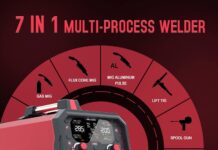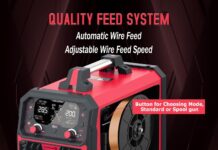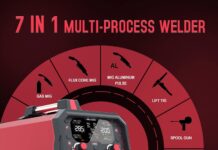MIG / MAG welding and TIG are the two types to consider when machining materials through the welding process.
Each has its advantages over the others, and in this article, we will list them individually and mark their differences.

Read Next – DEWALT Adjustable Steel Welding Table
Introduction to MIG and TIG Welding
When it comes to welding, there are a variety of techniques available, but two of the most popular methods are MIG and TIG welding.
Whether you’re a seasoned professional or just starting in metal fabrication, choosing the proper technique for your project is crucial.
But fear not! In this blog post, we’ll dive into the differences between MIG and TIG welding and help you determine the best suited for your needs.
So grab your helmet, and let’s get sparking!
TIG welding
The TIG system works with the heat generated by an electric arc that forms between the tungsten and the metal to be welded, where you can use or not supply metal.
This system uses gaseous protection to remove the air and avoid possible contamination by oxygen.
This system is beneficial when performing side pieces and then finishing a job.
It is usually used in aluminum or magnesium parts. Still, it can be applied to all metals, being the favorite method for thinner metals due to its precise temperature control.
Read Next – Best Tools Needed For Welding Our Top Picks
Advantages of using TIG welding:
- There are no emanations, splashes, or sparks. This is because no input metal circulates through the arc.
- Provides high-quality welds in all positions, even in hard-to-reach places.
- It is welding more resistant to deterioration, stronger, and more adaptable.
- Weld virtually all industrially used metals.
- Due to its gaseous protection, the welding area is prominent.
- No flux is required, and there is no need for subsequent cleaning in welding.
- The system can be automated, mechanically controlling the gun and metal.
MIG welding
Welding with inert metal gas (MIG) or welding with active gas metal (MAG) is a process in which an electric arc is formed between an electrode and a metal workpiece that heats metals, causing them to melt and join.
The soldier zone is generally protected from air pollution using an inert shield or cover gas (argon or helium).
In MIG welding, we can also say that an electric arc is established between the workpiece and the electrode, shaped like a wire.
When the inert Gas is activated, it is known by the acronym MAG. With this type of welding, you can work in three different ways, manual, semi-automatic, or automatic.
The most frequent use given to MIG welding is in small and medium thicknesses in steel structures, aluminum alloys, and also for non-ferrous materials.
Read Next – Top 5 Best Welding Tools Our Top Picks
MIG welding techniques:
- Short circuit transfer. When the short circuit is concrete, there is a change of metals. The tip of the wire thread joins the already molten weld.
- Spray transfer. It occurs when tiny metal droplets are removed from the tip of the wire and projected into the weld.
- Globular transfer occurs when said metal drops are too large to sink.
Advantages of using MIG welding:
- Increased productivity by eliminating dead time by replacing electrodes already consumed.
- It is possible to weld in any position.
- Cutting times are reduced.
- Reduction of the discontinuities of the cord, giving a good finish.
What is MIG welding?
MIG welding, also known as Gas Metal Arc Welding (GMAW), is a popular technique that uses a continuous wire electrode to create an electric arc between the workpiece and the welding gun. This creates heat, which melts the metal and fuses it.
One of the main advantages of MIG welding is its ease of use. It is considered one of the simplest forms of welding, making it ideal for beginners or those who need to complete projects quickly. The process can be automated with specialized equipment, increasing productivity in industrial settings.
Another benefit is that MIG welding can be used on various materials such as steel, stainless steel, aluminum, and copper alloys. This versatility makes it suitable for various applications, including automotive repairs, fabrication work, and even DIY projects at home.
Additionally, MIG welding allows for faster weld speeds compared to other methods like TIG welding. This means that large projects can be completed more efficiently without sacrificing quality.
However, there are some limitations to consider with MIG welding. One drawback is that it requires shielding Gas to protect the weld from contamination by atmospheric gases. This adds a cost factor and may be impractical in specific environments with wind or drafts.
In conclusion, MIG Welding offers numerous benefits, such as ease of use, faster weld speeds, and versatility.
However, it does require shielding gas which may not always be feasible.
The decision between using this technique and others will ultimately depend on your project requirements.
Hopefully, this brief introduction has given you some insight into MIG Welding.
Now let’s move on to discussing TIG Welding!
What is TIG welding?
What is TIG welding? Tungsten Inert Gas (TIG) welding, or Gas Tungsten Arc Welding (GTAW), is a precise and versatile welding technique.
It involves using a non-consumable tungsten electrode to create an electric arc that heats the metal being welded. The welder manually feeds filler material into the joint, which melts and fuses with the base metal.
One of the critical advantages of TIG welding is its ability to produce high-quality welds with excellent precision and control. This makes it particularly well-suited for intricate or delicate work, such as on thin materials or in applications where aesthetics are essential.
TIG welding allows for better heat control compared to other methods. A foot pedal enables the welder to adjust the amperage, allowing greater control over heat input. This helps prevent overheating or warping of thinner materials.
Additionally, TIG welding offers superior weld quality due to its clean and controlled fusion process. Proper techniques and equipment setup produce solid, durable joints with minimal porosity or defects.
Regarding versatility, TIG welding can be used on various metals like stainless steel, aluminum, copper alloys, and titanium. However,
it requires a higher skill level and longer processing times than MIG welding.
Overall, TIG welding excels in applications where precision, control, and aesthetics are paramount to achieving high-quality results.
Pros and Cons of MIG Welding
MIG welding, also known as Metal Inert Gas welding, is a popular technique used in various industries for its efficiency and versatility. Let’s explore the pros and cons of MIG welding to understand if it is the right choice for your project.
One significant advantage of MIG welding is its speed. This method allows for faster welds compared to other techniques, making it ideal for projects that require efficiency and productivity. Additionally, MIG welding can easily handle thicker materials, providing strong and durable welds.
Another benefit of MIG welding is its convenience when welding Gas. Unlike TIG welding, which requires separate shielding gas tanks, MIG welders have built-in gas systems that make the setup more accessible and convenient.
However, there are some downsides when using the MIG welding technique. One drawback is the potential for spatter during the process. Spatter refers to small pieces of molten metal that can splatter onto nearby surfaces or equipment. While this can be managed with proper precautions, such as using anti-spatter sprays or reducing voltage settings, it may still pose challenges in certain situations.
Furthermore, although MIG welds are generally considered solid and reliable, they may lack aesthetic appeal compared to TIG welds due to their larger bead size. If aesthetics are crucial for your project or working on thinner materials where precision matters most, you might consider TIG welding instead.
In conclusion (as per instructions), understanding the pros and cons of MIG welding will help you determine whether this technique fits your specific project requirements.
Welding Gas
Regarding MIG and TIG welding, the choice of welding gas is an important consideration. A shielding gas protects the weld pool from atmospheric contamination in MIG welding.
The most commonly used Gas for MIG welding is a mixture of argon and carbon dioxide. This combination provides good arc stability and penetration.
On the other hand, TIG welding requires a different type of shielding Gas. Argon is typically used to create an inert atmosphere around the weld area, preventing oxidation and ensuring clean welds. Other gases, such as helium or hydrogen, may be added to improve heat transfer or reduce porosity in specific applications.
The choice of welding gas can impact the quality and strength of your welds. Selecting the suitable Gas based on material type, thickness, and desired aesthetics is essential.
In summary (not conclusive), understanding which shielding Gas works best for your specific project will help you achieve optimal results with either MIG or TIG welding techniques.
Weld Speed
Weld speed is essential when deciding between MIG and TIG welding techniques. In MIG welding, the process is generally faster compared to TIG welding. This is because MIG welding uses a continuous wire feed, allowing for quicker deposition of filler material.
The fast weld speed offered by MIG welding can benefit projects where efficiency and productivity are critical. It allows for faster completion of welds, reducing overall project time and costs. Additionally, the high deposition rate of MIG welding allows for greater penetration into the base metal, resulting in solid and reliable welds.
On the other hand, TIG welding tends to have a slower weld speed due to its precise nature. The manual control required in TIG welding makes it more time-consuming than MIG welding. However, this slower pace can be advantageous in specific applications that require meticulous attention to detail or when working with thinner materials.
The choice between fast-paced MIG or slower but more precise TIG depends on your specific project requirements and priorities. Speed may be prioritized over precision in some cases, while others may demand a more intricate approach than only T.
Weld Strength
Weld Strength is crucial when choosing between MIG and TIG welding techniques for your project. Both methods have their pros and cons in terms of weld strength.
In MIG welding, the use of filler material provides excellent weld strength. The continuous wire feed creates a strong bond between the base metals, resulting in sturdy and durable welds. Additionally, MIG welding can penetrate deep into thick materials, ensuring a robust joint.
On the other hand, TIG welding also offers impressive weld strength due to its precise control over heat input. This technique allows for better fusion between the base metals, resulting in stronger joints. However, it’s worth noting that TIG welding may take longer than MIG welding due to its slower process.
The choice between MIG and TIG welding techniques depends on your specific project requirements and priorities regarding weld strength. Assessing factors such as material type and thickness will help determine the best method for achieving optimal joint integrity without compromising durability.
Pros and Cons of TIG Welding
TIG welding, also known as Gas Tungsten Arc Welding (GTAW), is a versatile and precise technique. It offers several advantages over other methods, but it also has its limitations.
One significant advantage of TIG welding is the ability to weld various materials, including stainless steel, aluminum, copper, and titanium. This makes it ideal for projects that require welding different types of metals.
Another benefit of TIG welding is the high-quality welds it produces. A tungsten electrode allows precise control over the heat input and fusion zone. As a result, TIG welds tend to be clean with minimal spatter or distortion.
TIG welding also provides excellent control over the weld pool size and shape. This enables welders to create intricate designs and perform delicate tasks such as thin sheet metal fabrication or pipe welding.
On the downside, TIG welding can be slower than other techniques like MIG welding. It requires more skill and experience due to its manual operation and finer controls. Additionally, TIG equipment can be more expensive than other types of welders.
While TIG welding may have some limitations in speed and cost-effectiveness, its precision and versatility make it an excellent choice for projects that demand high-quality results on various materials.
Electrode
Electrode plays a crucial role in TIG welding, as it creates and maintains the arc between the electrode and the workpiece. This small but mighty component acts as a conductor of electricity, transferring heat to melt the metal and form a weld joint.
One key advantage of TIG welding is that it allows precise electrode control. Operators can choose different types of electrodes based on their specific needs. For example, thoriated tungsten electrodes are commonly used for general applications, while created tungsten electrodes are preferred for low-current projects.
The choice of electrode also depends on factors such as material type, thickness, and desired weld quality. Different electrodes have varying levels of conductivity and melting points, which can impact overall performance.
Another aspect to consider is electrode size. Thinner electrodes provide better control over heat input, making them suitable for delicate or thin materials. On the other hand, larger diameter electrodes offer improved durability and stability when working with thicker metals.
Selecting the right electrode requires careful consideration of project requirements and material characteristics. By choosing wisely, welders can achieve optimal results in terms of both appearance and structural integrity.
Shielding Gas
Shielding Gas is crucial in TIG welding, as it helps create a protective atmosphere around the weld pool. This Gas acts as a shield, preventing contaminants from entering the weld and causing defects. The most commonly used shielding gases for TIG welding are argon and helium.
Argon is widely preferred for its affordability and versatility. It creates a stable arc, which results in cleaner welds with minimal spatter. Argon also provides good penetration and control over heat input, making it suitable for various applications.
Helium, on the other hand, offers higher heat conductivity than argon. This can be advantageous when working with thicker materials or when more significant heat input is required.
In some cases, a mixture of argon and helium may be used to optimize performance based on specific project requirements.
Choosing the suitable shielding Gas is essential based on material type and thickness. Consulting with an experienced welder or referring to welding guidelines can help determine the appropriate choice of shielding Gas for your project.
Remember that proper selection and use of shielding gas play a significant role in achieving high-quality TIG welds.
Welding Torch
Regarding TIG welding, one of the essential components is the welding torch. This tool is crucial in delivering the precise heat and control required for intricate welds.
The TIG welding torch features a long handle for comfortable grip and maneuverability. When brought near the workpiece, it is equipped with a non-consumable tungsten electrode that produces an arc. The electrode can withstand high temperatures without melting, making it suitable for various applications.
The torch also incorporates a shielding gas nozzle that surrounds the electrode and protects the molten metal and tungsten from oxidation or contamination. By controlling shielding Gas flow through this nozzle, welders ensure clean and robust welds.
Furthermore, TIG welding torches often come with adjustable amperage controls, which allow operators to fine-tune their settings based on specific project requirements. This feature offers flexibility and precision during welds.
Regarding design, some TIG torches have interchangeable heads or handles to accommodate different electrode sizes or provide better accessibility in tight spaces.
Choosing the suitable TIG welding torch is crucial for achieving high-quality results in projects that require precision and control over heat input. Welders must consider ergonomics, durability, ease of use, and compatibility with their power source before selecting a suitable torch.
Power Source
Regarding the power source used in welding, both MIG and TIG techniques have unique requirements. A constant voltage or CV power source is typically used in MIG welding. This means that the power source maintains a consistent voltage output while the wire feed speed is adjusted to control heat input.
On the other hand, TIG welding requires a constant current or CC power source. With this power source, the amperage remains steady, while voltage can be adjusted depending on the specific application.
The choice of power source ultimately depends on material thickness and desired weld quality. For thicker materials that require higher amperage, a CC power source used in TIG welding may be more suitable. Conversely, a CV power source in MIG welding might be preferred for thinner materials where precise control of heat input is essential.
It’s worth noting that some modern machines offer dual functionality with both CC and CV capabilities, providing greater versatility for different projects and allowing users to switch between MIG and TIG techniques easily.
Understanding your specific project requirements will help you determine which type of power source is most appropriate for achieving optimal results in your welding endeavors.
Forney Easy Weld 261, 140 FC-i MIG Welder, 120V, Green
$149.00 in stock
2 used from $140.06





















































